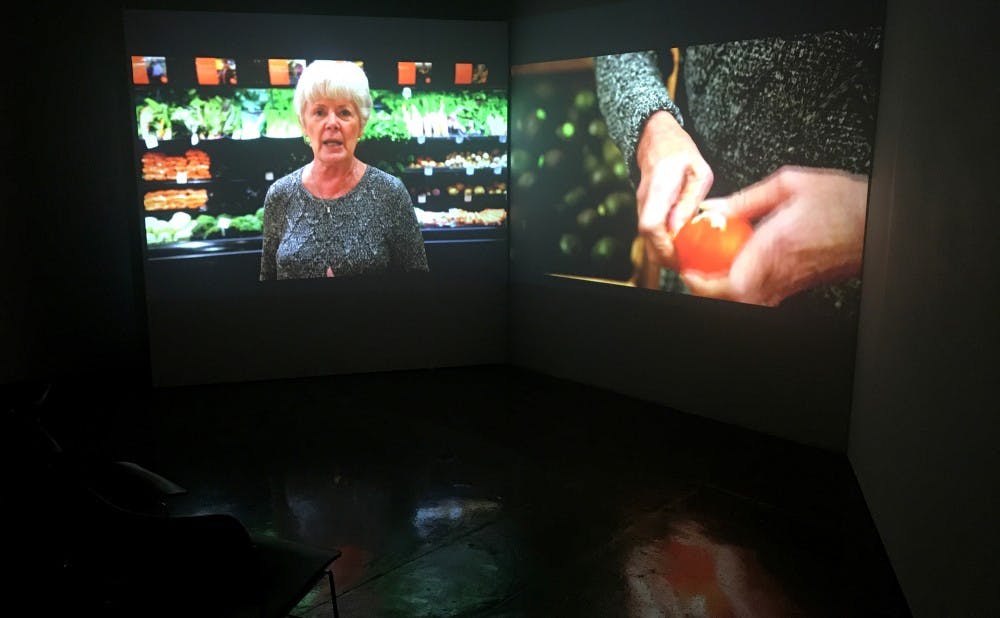For its latest installation, the Power Plant Gallery, located on the American Tobacco Campus, consists of a darkened brick room. Although the darkened windows are a practicality for viewing the installation, titled “The Way Things Can Happen,” the setup creates a sense of entering an underground bomb shelter, a fitting home for an exhibit about the dangers of nuclear war.
Erin Johnson’s “The Way Things Can Happen,” on display at the Power Plant Gallery until March 3, features extras from the popular 1983 television film “The Day After.” The film depicts a nuclear attack on Kansas and was shot on location in Lawrence, Kan., with a cast of 5,000 extras from the area. Over 100 million people watched the film live when it first premiered, and it is one of the highest-rated television films in history. Artist Erin Johnson visited Lawrence last summer to film a retelling of “The Day After” in a documentary style. Actors stand in front of normal backgrounds — a supermarket, a basketball court, a field — and discuss the outcome of the nuclear strike in matter-of-fact tones.
“I was really interested in the idea that a large group of people from this one community had played out this nightmare, the country’s worst fear,” Johnson said.
She added that the original film “The Day After” had a large impact not only on its viewers, but on the people who were featured in it. Using the extras from the film added a personal and immediate sense to her project. In using real people from the film and from Lawrence, Johnson creates a form of pseudo-reality, where the actors do have a connection to nuclear war without having actually experienced it themselves.
“They were extras in the film. They were lying on the floor in the gym, or they were a part of the crowd in the field. So in some ways they really did live this experience,” said Caitlin Kelly, director of the Power Plant Gallery.
Johnson added that although “The Day After” itself was fictional, it did have real world implications in contributing to the national discussion around nuclear power during the Cold War.
“I’m interested in seeing what happens when the blurring of fact and fiction take place and what kind of possibilities that blurring might bring about,” Johnson said.
“The Way Things Can Happen” can be enjoyed without previously seeing “The Day After.” Even the nuclear strike itself is only alluded to, as the installation deals primarily with the personal effects of a nuclear disaster instead of the actual event. This strategy allows the viewer to imagine what must have happened to create this post-apocalyptic world.
“I think you can be bothered by this work all on its own,” Kelly said.
The exhibit opens at an appropriate time, as President Donald Trump traded threats of nuclear war with Kim Jong-Un over Twitter earlier this month. The fear of nuclear strike is more popular in the news now than it has been in years, which is what piqued Kelly’s interest in featuring this exhibit. “The Way Things Can Happen” makes these currents events much more intimate.
“It takes that larger rhetoric that’s happening outside, whether it’s on Twitter or on the news, and it makes it more personal,” Kelly said. “And hopefully we can pay attention to it.”
A particularly chilling feature of the exhibit is the inclusion of pamphlets and videos from the 1960s dealing with the topic of radiation and nuclear disaster. The pamphlets, reprinted with permission from the Duke Medical Archives, discuss how to build a nuclear shelter, how to survive atomic war and a psychological study of how humans react in a simulated bomb shelter.
“The Way Things Can Happen” is accompanied by a number of events, such as the Nuclear War Film Series. The Power Plant Gallery is showing “Buzz One Four,” a documentary by Matt McCormick, Feb. 8. A panel discussion on creative responses to the threat of nuclear war will be held Feb. 15, and Johnson herself will talk about “The Way Things Can Happen” at a public talk Feb. 16.
The Power Plant Gallery was founded in September 2013 through Duke University. It was a joint initiative between the Center for Documentary Studies and the M.F.A. in Experimental and Documentary Arts. The gallery showcases documentary work, although it does show more experimental work as well. It also hosts the Duke M.F.A. thesis shows and panel discussions, tending to focus on the idea of art and activism. Johnson’s exhibit is being shown there for the first time.
In the Power Plant Gallery, it is possible to believe that Erin Johnson’s film is real and that you are seeing it in a post-apocalyptic world. It is almost a relief to step outside into the Durham sunshine and realize that nuclear disaster is, for now, only a faint possibility.
Get The Chronicle straight to your inbox
Sign up for our weekly newsletter. Cancel at any time.

